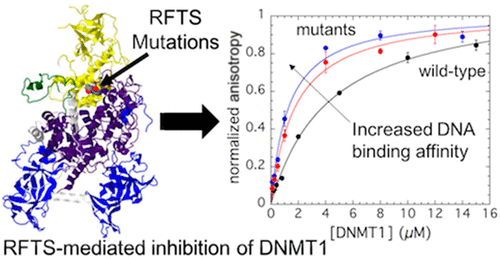当前位置:
X-MOL 学术
›
Biochemistry
›
论文详情
Our official English website, www.x-mol.net, welcomes your
feedback! (Note: you will need to create a separate account there.)
Disease-Associated Mutations G589A and V590F Relieve Replication Focus Targeting Sequence-Mediated Autoinhibition of DNA Methyltransferase 1.
Biochemistry ( IF 2.9 ) Pub Date : 2019-12-16 , DOI: 10.1021/acs.biochem.9b00749 Emma K Dolen 1 , James H McGinnis 2 , Rachel N Tavory 2 , Jill A Weiss 2 , Rebecca L Switzer 1
Biochemistry ( IF 2.9 ) Pub Date : 2019-12-16 , DOI: 10.1021/acs.biochem.9b00749 Emma K Dolen 1 , James H McGinnis 2 , Rachel N Tavory 2 , Jill A Weiss 2 , Rebecca L Switzer 1
Affiliation

|
In eukaryotes, the most common epigenetic DNA modification is methylation of carbon 5 of cytosines, predominantly in CpG dinucleotides. Methylation patterns are established and maintained by a family of proteins known as DNA methyltransferases (DNMTs). DNA methylation is an important epigenetic mark associated with gene repression, and disruption of the normal DNA methylation pattern is known to play a role in several disease states. Methylation patterns are primarily maintained by DNMT1, which possesses specificity for methylation of hemimethylated DNA. DNMT1 is a multidomain protein with a C-terminal catalytic methyltransferase domain and a large N-terminal regulatory region. The replication focus targeting sequence (RFTS) domain, found in the regulatory region, is an endogenous inhibitor of DNMT1 activity. Recently, several mutations in the RFTS domain were shown to be causal for two adult onset neurodegenerative diseases; however, little is known about the impact of these mutations on the structure and function of DNMT1. Two of these mutations, G589A and V590F, are associated with development of autosomal dominant cerebellar ataxia, deafness, and narcolepsy (ADCA-DN). We have successfully expressed and purified G589A and V590F DNMT1 for in vitro studies. The mutations significantly decrease the thermal stability of DNMT1, yet the mutant proteins exhibit 2.5-3.5-fold increases in DNA binding affinity. In addition, the mutations weaken RFTS-mediated inhibition of DNA methylation activity. Taken together, these data suggest these disease-associated mutations decrease protein stability and, at least partially, relieve normal RFTS-mediated autoinhibition of DNMT1.
中文翻译:

与疾病相关的突变G589A和V590F消除了以靶向序列介导的DNA甲基转移酶自动抑制为目标的复制焦点。
在真核生物中,最常见的表观遗传学DNA修饰是胞嘧啶碳5的甲基化,主要存在于CpG二核苷酸中。甲基化模式由称为DNA甲基转移酶(DNMT)的蛋白质家族建立和维持。DNA甲基化是与基因阻抑相关的重要表观遗传标记,正常DNA甲基化模式的破坏在几种疾病状态中起着重要作用。甲基化模式主要由DNMT1维持,DNMT1对半甲基化DNA的甲基化具有特异性。DNMT1是具有C端催化甲基转移酶结构域和大N端调节区的多域蛋白。在调节区域中发现的复制焦点靶向序列(RFTS)域是DNMT1活性的内源性抑制剂。最近,结果表明,RFTS结构域中的几个突变是导致两种成人发作性神经退行性疾病的原因。但是,对于这些突变对DNMT1的结构和功能的影响知之甚少。其中两个突变G589A和V590F与常染色体显性遗传性小脑共济失调,耳聋和嗜睡症(ADCA-DN)的发生有关。我们已经成功表达和纯化了G589A和V590F DNMT1,用于体外研究。突变显着降低了DNMT1的热稳定性,但突变蛋白的DNA结合亲和力却提高了2.5-3.5倍。此外,突变减弱了RFTS介导的DNA甲基化活性的抑制。综上所述,这些数据表明这些与疾病相关的突变降低了蛋白质的稳定性,并且至少部分地降低了蛋白质的稳定性。
更新日期:2019-12-17
中文翻译:

与疾病相关的突变G589A和V590F消除了以靶向序列介导的DNA甲基转移酶自动抑制为目标的复制焦点。
在真核生物中,最常见的表观遗传学DNA修饰是胞嘧啶碳5的甲基化,主要存在于CpG二核苷酸中。甲基化模式由称为DNA甲基转移酶(DNMT)的蛋白质家族建立和维持。DNA甲基化是与基因阻抑相关的重要表观遗传标记,正常DNA甲基化模式的破坏在几种疾病状态中起着重要作用。甲基化模式主要由DNMT1维持,DNMT1对半甲基化DNA的甲基化具有特异性。DNMT1是具有C端催化甲基转移酶结构域和大N端调节区的多域蛋白。在调节区域中发现的复制焦点靶向序列(RFTS)域是DNMT1活性的内源性抑制剂。最近,结果表明,RFTS结构域中的几个突变是导致两种成人发作性神经退行性疾病的原因。但是,对于这些突变对DNMT1的结构和功能的影响知之甚少。其中两个突变G589A和V590F与常染色体显性遗传性小脑共济失调,耳聋和嗜睡症(ADCA-DN)的发生有关。我们已经成功表达和纯化了G589A和V590F DNMT1,用于体外研究。突变显着降低了DNMT1的热稳定性,但突变蛋白的DNA结合亲和力却提高了2.5-3.5倍。此外,突变减弱了RFTS介导的DNA甲基化活性的抑制。综上所述,这些数据表明这些与疾病相关的突变降低了蛋白质的稳定性,并且至少部分地降低了蛋白质的稳定性。











































 京公网安备 11010802027423号
京公网安备 11010802027423号